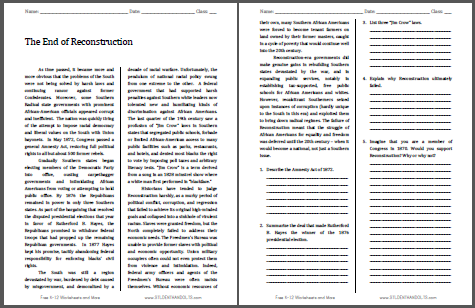| The End of Reconstruction Reading with Questions |
|---|
| www.studenthandouts.com ↣ American History ↣ American History Readings |
 As time passed, it became more and more obvious that the problems of the South were not being solved by harsh laws and continuing rancor against former Confederates. Moreover, some Southern Radical state governments with prominent African-American officials appeared corrupt and inefficient. The nation was quickly tiring of the attempt to impose racial democracy and liberal values on the South with Union bayonets. In May 1872, Congress passed a general Amnesty Act, restoring full political rights to all but about 500 former rebels.
As time passed, it became more and more obvious that the problems of the South were not being solved by harsh laws and continuing rancor against former Confederates. Moreover, some Southern Radical state governments with prominent African-American officials appeared corrupt and inefficient. The nation was quickly tiring of the attempt to impose racial democracy and liberal values on the South with Union bayonets. In May 1872, Congress passed a general Amnesty Act, restoring full political rights to all but about 500 former rebels.Gradually Southern states began electing members of the Democratic Party into office, ousting carpetbagger governments and intimidating African Americans from voting or attempting to hold public office. By 1876 the Republicans remained in power in only three Southern states. As part of the bargaining that resolved the disputed presidential elections that year in favor of Rutherford B. Hayes, the Republicans promised to withdraw federal troops that had propped up the remaining Republican governments. In 1877 Hayes kept his promise, tacitly abandoning federal responsibility for enforcing blacks' civil rights. The South was still a region devastated by war, burdened by debt caused by misgovernment, and demoralized by a decade of racial warfare. Unfortunately, the pendulum of national racial policy swung from one extreme to the other. A federal government that had supported harsh penalties against Southern white leaders now tolerated new and humiliating kinds of discrimination against African Americans. The last quarter of the 19th century saw a profusion of "Jim Crow" laws in Southern states that segregated public schools, forbade or limited African-American access to many public facilities such as parks, restaurants, and hotels, and denied most blacks the right to vote by imposing poll taxes and arbitrary literacy tests. "Jim Crow" is a term derived from a song in an 1828 minstrel show where a white man first performed in "blackface." Historians have tended to judge Reconstruction harshly, as a murky period of political conflict, corruption, and regression that failed to achieve its original high-minded goals and collapsed into a sinkhole of virulent racism. Slaves were granted freedom, but the North completely failed to address their economic needs. The Freedmen's Bureau was unable to provide former slaves with political and economic opportunity. Union military occupiers often could not even protect them from violence and intimidation. Indeed, federal army officers and agents of the Freedmen's Bureau were often racists themselves. Without economic resources of their own, many Southern African Americans were forced to become tenant farmers on land owned by their former masters, caught in a cycle of poverty that would continue well into the 20th century. Reconstruction-era governments did make genuine gains in rebuilding Southern states devastated by the war, and in expanding public services, notably in establishing tax-supported, free public schools for African Americans and whites. However, recalcitrant Southerners seized upon instances of corruption (hardly unique to the South in this era) and exploited them to bring down radical regimes. The failure of Reconstruction meant that the struggle of African Americans for equality and freedom was deferred until the 20th century—when it would become a national, not just a Southern issue. Click here to print this worksheet. Answer Key: (1) Restored full political rights to all but about 500 former rebels; (2) Republicans promised to withdraw federal troops from the South; (3) Segregation of public schools, limiting or forbidding African Americans access to many public facilities, and denial of the right to vote through literacy tests and poll taxes; (4) Answers will vary; (5) Answers will vary. |
 |  |  |  |  |  |
| www.studenthandouts.com ↣ American History ↣ American History Readings |








